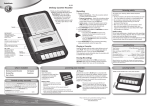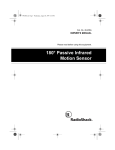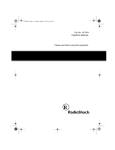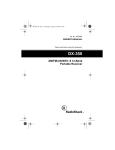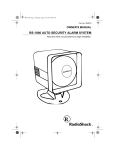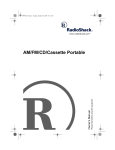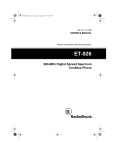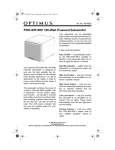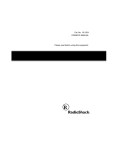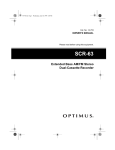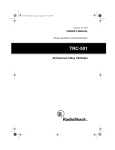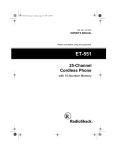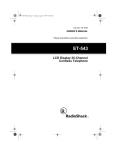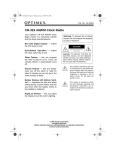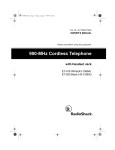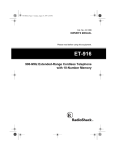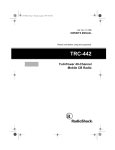Download Optimus CTR-110 Cassette Player User Manual
Transcript
14-733.fm Page 1 Thursday, July 1, 1999 9:00 AM Cat. No. 14-733 OWNER’S MANUAL Please read before using this equipment. CTR-110 Extended Bass AM/FM Cassette Recorder 14-733.fm Page 2 Thursday, July 1, 1999 9:00 AM FEATURES Your Optimus CTR-110 Extended Bass AM/FM Cassette Recorder is a versatile, easy-to-use music system with many useful features. You can record live or from the radio, or just enjoy the radio or cassette player's high quality sound. batteries, standard AC power (using an optional AC adapter), or a vehicle’s DC power (using an optional DC adapter). The CTR-110's compact design and handy carrying handle let you take it almost anywhere. Its features include: Dual-Source Recording — lets you record from the radio or use the builtin microphone to make a live shortdistance recording. Automatic Level Control — automatically adjusts the recording level. One-Touch Recording — lets you start recording quickly and easily. Soft Cassette Tape Eject — gently opens the cassette compartment cover so the cassette does not pop out. PHONE Jack — lets you connect optional earphones so you can listen in privacy. Extended Bass Switch — boosts low frequency sounds. Three Power Sources — let you power the CTR-110 from internal © 1997 Tandy Corporation. All Rights Reserved. Optimus and RadioShack are registered trademarks used by Tandy Corporation. 2 14-733.fm Page 3 Thursday, July 1, 1999 9:00 AM CONTENTS Preparation ..................................................................................................... Power Sources .......................................................................................... Using Batteries .................................................................................... Using AC Power .................................................................................. Using Vehicle Power ........................................................................... Using Earphones ....................................................................................... Listening Safely ................................................................................... Traffic Safety ....................................................................................... 4 4 4 5 5 6 6 7 Radio Operation ............................................................................................. 8 Cassette Player Operation ............................................................................. 9 Loading a Cassette Tape ........................................................................... 9 Playing a Cassette Tape ............................................................................ 9 Recording ................................................................................................ 10 Recording from the Radio ................................................................. 10 Making Live Recordings .................................................................... 10 Tape Tips ................................................................................................. 11 Recommended Tapes ....................................................................... 11 Recording Over or Erasing a Cassette Tape ..................................... 11 Preventing Accidental Erasure .......................................................... 11 Restoring Tape Tension and Sound Quality ...................................... 12 Care and Maintenance ................................................................................. 13 Cleaning the Tape Handling Parts ........................................................... 14 The FCC Wants You to Know .................................................................. 14 Specifications ............................................................................................... 15 3 14-733.fm Page 4 Thursday, July 1, 1999 9:00 AM PREPARATION POWER SOURCES You can operate the CTR-110 using: • Internal battery power (using four C batteries) 2. Put four C batteries in the compartment, as indicated by the polarity symbols (+ and –) marked inside. • AC power (using an optional AC adapter) Illustration • Vehicle battery power (using an optional DC adapter) Note: Internal batteries automatically disconnect when you connect an adapter. Cautions: Using Batteries • Do not mix old and new batteries, different types of batteries (standard, alkaline, or rechargeable), or rechargeable batteries of different capacities. You can power the CTR-110 from four C batteries (not supplied). For the best performance and longest life, we recommend alkaline batteries, such as RadioShack Cat. No. 23551. 1. Turn the CTR-110 on its face, pull the tabs on the battery compartment’s cover and remove the cover. • Use only fresh batteries of the required size and recommended type. 3. Replace the cover and snap it shut. If the CTR-110 does not operate properly or if the sound weakens or distorts, replace the batteries. Cautions: Illustration • Dispose of the old batteries promptly and properly. Do not bury or burn them. • Never leave dead, old, or weak batteries in the CTR-110. Batteries can leak chemicals that can destroy electronic parts. 4 14-733.fm Page 5 Thursday, July 1, 1999 9:00 AM • If you do not plan to use the CTR-110 from battery power for a month or more, or if you plan to use only an adapter, remove the batteries to protect the CTR110 from possible battery leakage. 2. Insert the AC adapter’s 5.5 mm outer diameter/2.1 mm inner diameter barrel plug into the adapter cord’s small end so it reads –TIP, then insert the adapter’s plug into the DC 6V jack on the back of the CTR-110. Using AC Power You can power the CTR-110 from standard AC power using an optional AC adapter, such as RadioShack Cat. No. 273-1663. Cautions: • The recommended AC adapter supplies 6 volts and delivers at least 400 milliamps. Its center tip is set to negative, and its plug correctly fits the CTR-110’s DC 6V jack. Using an AC adapter that does not meet these specifications could damage the CTR110 or the adapter. • Always plug the adapter into the CTR-110 before you plug it into the AC outlet, and always unplug the adapter from the AC outlet before you unplug it from the CTR-110. 1. Set the AC adapter’s voltage switch to 6V. Illustration 3. Plug the adapter into a standard AC outlet. Using Vehicle Power You can power the CTR-110 from your vehicle’s battery using an optional DC adapter, such as RadioShack Cat. No. 273-1802. Cautions: • The recommended DC adapter supplies 6 volts and delivers at least 400 milliamps. Its center tip is set to negative, and its plug correctly fits the CTR-110’s DC 6V jack. Using a DC adapter that does not meet these specifications could damage the CTR110 or the adapter. 5 14-733.fm Page 6 Thursday, July 1, 1999 9:00 AM • Always plug the adapter into the CTR-110 before you plug it into the cigarette-lighter socket, and always unplug the adapter from the cigarette-lighter socket before you unplug it from the CTR-110. Insert the earphones’ 1/8-inch plug into the PHONE jack on the top of the CTR-110. Illustration Follow these steps to use your vehicle’s battery. Illustration Note: Connecting earphones automatically disconnects the built-in speaker. Listening Safely 1. Set the DC adapter’s voltage switch to 6V. 2. Insert the DC adapter’s barrel plug into the CTR-110’s DC 6V jack. 3. Insert the other end of the adapter into your vehicle’s cigarette-lighter socket. USING EARPHONES For private listening, you can connect a pair of earphones (not supplied) with a 1/8-inch plug. Your local RadioShack store carries a wide selection of earphones. 6 To protect your hearing, follow these guidelines when you use earphones. • Set the volume to the lowest setting before you begin listening. After you begin listening, adjust the volume to a comfortable level. • Do not listen at extremely high volume levels. Extended highvolume listening can lead to permanent hearing loss. • Once you set the volume, do not increase it. Over time, your ears adapt to the volume level, so a volume level that does not cause discomfort might still damage your hearing. 14-733.fm Page 7 Thursday, July 1, 1999 9:00 AM Traffic Safety Do not wear earphones while operating a motor vehicle or riding a bicycle. This can create a traffic hazard and could be illegal in some areas. Even though some earphones are designed to let you hear some outside sounds when listening at normal volume levels, they still can present a traffic hazard. 7 14-733.fm Page 8 Thursday, July 1, 1999 9:00 AM RADIO OPERATION 1. Set FUNCTION to RADIO to turn on the radio. Illustration 2. Set BAND to AM or FM. 4. Adjust VOLUME MIN/MAX to a comfortable listening level. Illustration 5. Set E-BASS ON/OFF to ON to boost low frequency sounds. Set it to OFF for normal bass sound. Illustration Illustration 3. Rotate the tuning control to select the desired station. 6. Set FUNCTION to TAPE to turn off the radio. Illustration Illustration Notes: • The AM antenna is built-in. To improve AM reception, reposition the CTR-110. • For the best FM reception, fully extend the telescoping antenna and swivel it to the position that produces the best reception. 8 14-733.fm Page 9 Thursday, July 1, 1999 9:00 AM CASSETTE PLAYER OPERATION LOADING A CASSETTE TAPE 1. Take up any slack in the tape by turning the cassette’s hub with a pencil. If you do not remove excess slack, the tape could become tangled in the record/ playback mechanism. 4. Gently close the compartment’s door. PLAYING A CASSETTE TAPE 1. Set FUNCTION to TAPE. 2. With a cassette loaded in the compartment, press PLAY. Illustration Illustration 2. Press STOP/EJECT to open the cassette compartment’s door. Illustration Notes: • Press PAUSE to temporarily stop playback. Press PAUSE again to resume playback. Illustration 3. Load the cassette with its open edge facing up, its full reel to the right, and the desired side toward you. Illustration to fast-for• Press FAST-F ward, or REWIND to rewind the tape to the desired location. Illustration 9 14-733.fm Page 10 Thursday, July 1, 1999 9:00 AM 3. Adjust VOLUME MIN/MAX to a comfortable listening level. 4. Set E-BASS ON/OFF to ON to boost low frequency sounds. Set it to OFF for normal bass sound. 5. Press STOP/EJECT to stop playback before it automatically stops. Press STOP/EJECT again to open the cassette compartment and remove the cassette tape. Recording from the Radio 1. Load a blank cassette tape, or one you want to record over, into the cassette compartment. 2. Set FUNCTION to RADIO. 3. Set BAND to AM or FM. 4. Adjust TUNING to the station you want to record. 5. Press RECORD to begin recording. PLAY and RECORD lock down. RECORDING You can record from the radio or use the built-in microphone to make a live recording. Caution: Before you load a cassette tape for recording, be sure its eraseprotection tabs are in place. If you force down RECORD when a tape side’s erase-protection tab is missing, you will damage the record mechanism (see “Preventing Accidental Erasure” on Page 11). Notes: • The CTR-110’s Automatic Level Control (ALC) automatically adjusts the recording level. VOLUME MIN/MAX has no effect on recording. • To record on the other side of the tape, you must turn it over. 10 Illustration Note: To temporarily stop recording, press PAUSE . To resume recording, press PAUSE again. 6. Press STOP/EJECT recording. to stop Making Live Recordings Follow these steps to make live recordings using the built-in microphone. 1. Load a blank cassette tape, or one you want to record over, into the cassette compartment. 2. Set FUNCTION to TAPE . 14-733.fm Page 11 Thursday, July 1, 1999 9:00 AM 3. Place the CTR-110 1–2 feet from the recording source. 4. Press RECORD to begin recording. PLAY and RECORD lock down. Note: To temporarily stop recording, press PAUSE . To resume recording, press PAUSE again. 5. Press STOP/EJECT recording. to stop Preventing Accidental Erasure Cassette tapes have two eraseprotection tabs, one for each side. When a tab is in place, you can record on that side. To protect a recording from being accidentally recorded over or erased, use a screwdriver to remove one or both of the cassette tape’s eraseprotection tabs. This prevents RECORD from being pressed. TAPE TIPS Recommended Tapes Tape quality greatly affects the quality of the recording. We recommend extended-range or low noise type 1 regular length (60 or 90-minute) normal-bias cassette tapes. We do not recommend long-play cassette tapes such as C-120s because they are thin and can easily tangle. Recording Over or Erasing a Cassette Tape To record over a cassette tape, simply record as usual. The cassette deck records over the previous recording. Illustration If you later decide to record on a tape side after you have removed the erase-protection tab, place a piece of strong plastic tape over that side’s erase-protection hole. Be sure you cover only the hole originally covered by the erase-protection tab. Illustration You can quickly erase both sides of a cassette tape using a bulk tape eraser available at your local RadioShack store. 11 14-733.fm Page 12 Thursday, July 1, 1999 9:00 AM Caution: Removing the eraseprotection tabs does not prevent a bulk eraser from erasing a cassette tape. Restoring Tape Tension and Sound Quality After you play a cassette tape several times, the tape might become tightly wound on the reels. This can cause playback sound quality to deteriorate. To restore the sound quality, fastforward the tape from the beginning to the end of one side, then completely rewind it. Then loosen the tape reels by gently tapping each side of the cassette’s outer shell on a flat surface. Caution: Be careful not to damage the cassette when tapping it. Do not touch the exposed tape or allow any sharp objects near the cassette. 12 14-733.fm Page 13 Thursday, July 1, 1999 9:00 AM CARE AND MAINTENANCE Your Optimus CTR-110 Extended Bass AM/FM Cassette Recorder is an example of superior design and craftsmanship. The following suggestions will help you care for your CTR-110 so you can enjoy it for years. Keep the CTR-110 dry. If it gets wet, wipe it dry immediately. Liquids might contain minerals that can corrode the electronic circuits. Use and store the CTR-110 only in normal temperature environments. Temperature extremes can shorten the life of electronic devices, damage batteries, and distort or melt plastic parts. Keep the CTR-110 away from dust and dirt, which can cause premature wear of parts. Handle the CTR-110 gently and carefully. Dropping it can damage circuit boards and cases and can cause the CTR-110 to work improperly. Use only fresh batteries of the required size and type. Batteries can leak chemicals that damage your CTR-110’s electronic parts. Wipe the CTR-110 with a damp cloth occasionally to keep it looking new. Do not use harsh chemicals, cleaning solvents, or strong detergents to clean the CTR-110. Modifying or tampering with the CTR-110’s internal components can cause a malfunction, invalidate your CTR-110’s warranty, and void your FCC authorization to operate it. If your CTR-110 is not performing as it should, take it to your local RadioShack store for assistance. 13 14-733.fm Page 14 Thursday, July 1, 1999 9:00 AM CLEANING THE TAPE HANDLING PARTS Dirt, dust, or particles of the tape’s coating can accumulate on the tape heads and other parts that the tape touches. This can greatly reduce the cassette player’s performance. To prevent noise and poor highfrequency response, clean the cassette player’s tape handling parts after every 20 hours of use. Your local RadioShack store sells a complete line of cassette deck cleaning supplies. 1. Set FUNCTION to TAPE. 2. Remove the batteries and disconnect any other power source. 3. Press STOP/EJECT to open the cassette compartment’s cover. 4. Hold down the erase-protection tab sensor, then press RECORD to expose the tape handling parts. clean the capstan, pinch rollers, tape guides, and tape heads. Illustration 6. Press STOP/EJECT and close the cassette compartment’s cover. Then reconnect power. THE FCC WANTS YOU TO KNOW Your CTR-110 might cause TV or radio interference even when it is operating properly. To determine whether your CTR-110 is causing the interference, turn off your CTR-110. If the interference goes away, your CTR-110 is causing it. Try to eliminate the interference by: • Moving your CTR-110 from the receiver Illustration • Connecting your CTR-110 to an outlet that is on a different electrical circuit from the receiver • Contacting your local dioShack store for help 5. Use a cotton swab dipped in tape head cleaning solution or denatured alcohol to gently 14 away Ra- If you cannot eliminate the interference, the FCC requires that you stop using your CTR-110. 14-733.fm Page 15 Thursday, July 1, 1999 9:00 AM SPECIFICATIONS RADIO Frequency Range: FM............................................................................................. 88–108 MHz AM ........................................................................................ 530–1710 kHz Antenna: FM ............................................................................... Telescoping Antenna AM ............................................................................................. Ferrite Rod CASSETTE PLAYER Track System ................................................................................ 2 Track Mono Tape Speed ............................................................................... 17/8 inch/second Recording System ........................................................ DC Bias, Magnet Erase Frequency Response (Play) at ±6 dB ........................................... 125–6300 Hz Frequency Response (Record/Play) at ±6 dB................................ 125–4000 Hz Wow and Flutter .......................................................................... 0.3% (WRMS) GENERAL Power Requirements ....................................................... DC 6V (4 C Batteries) Power Consumption .................................................................................. 0.7 W Dimensions .......................................................... 55/16 × 11 × 33/4 Inches (HWD) (135 x 280 x 95 mm) Weight ..................................................................................................... 38.8 oz (1.1 Kg) Specifications are typical; individual units might vary. Specifications are subject to change and improvement without notice. 15 14-733.fm Page 16 Thursday, July 1, 1999 9:00 AM Limited Ninety-Day Warranty This product is warranted by RadioShack against manufacturing defects in material and workmanship under normal use for ninety (90) days from the date of purchase from RadioShack companyowned stores and authorized RadioShack franchisees and dealers. EXCEPT AS PROVIDED HEREIN, RadioShack MAKES NO EXPRESS WARRANTIES AND ANY IMPLIED WARRANTIES, INCLUDING THOSE OF MERCHANTABILITY AND FITNESS FOR A PARTICULAR PURPOSE, ARE LIMITED IN DURATION TO THE DURATION OF THE WRITTEN LIMITED WARRANTIES CONTAINED HEREIN. EXCEPT AS PROVIDED HEREIN, RadioShack SHALL HAVE NO LIABILITY OR RESPONSIBILITY TO CUSTOMER OR ANY OTHER PERSON OR ENTITY WITH RESPECT TO ANY LIABILITY, LOSS OR DAMAGE CAUSED DIRECTLY OR INDIRECTLY BY USE OR PERFORMANCE OF THE PRODUCT OR ARISING OUT OF ANY BREACH OF THIS WARRANTY, INCLUDING, BUT NOT LIMITED TO, ANY DAMAGES RESULTING FROM INCONVENIENCE, LOSS OF TIME, DATA, PROPERTY, REVENUE, OR PROFIT OR ANY INDIRECT, SPECIAL, INCIDENTAL, OR CONSEQUENTIAL DAMAGES, EVEN IF RadioShack HAS BEEN ADVISED OF THE POSSIBILITY OF SUCH DAMAGES. Some states do not allow the limitations on how long an implied warranty lasts or the exclusion of incidental or consequential damages, so the above limitations or exclusions may not apply to you. In the event of a product defect during the warranty period, take the product and the RadioShack sales receipt as proof of purchase date to any RadioShack store. RadioShack will, at its option, unless otherwise provided by law: (a) correct the defect by product repair without charge for parts and labor; (b) replace the product with one of the same or similar design; or (c) refund the purchase price. All replaced parts and products, and products on which a refund is made, become the property of RadioShack. New or reconditioned parts and products may be used in the performance of warranty service. Repaired or replaced parts and products are warranted for the remainder of the original warranty period. You will be charged for repair or replacement of the product made after the expiration of the warranty period. This warranty does not cover: (a) damage or failure caused by or attributable to acts of God, abuse, accident, misuse, improper or abnormal usage, failure to follow instructions, improper installation or maintenance, alteration, lightning or other incidence of excess voltage or current; (b) any repairs other than those provided by a RadioShack Authorized Service Facility; (c) consumables such as fuses or batteries; (d) cosmetic damage; (e) transportation, shipping or insurance costs; or (f) costs of product removal, installation, set-up service adjustment or reinstallation. This warranty gives you specific legal rights, and you may also have other rights which vary from state to state. RadioShack Customer Relations, Dept. W, 100 Throckmorton St., Suite 600, Fort Worth, TX 76102 We Service What We Sell 3/97 RadioShack A Division of Tandy Corporation Fort Worth, Texas 76102 12A7 Printed in Hong Kong

















